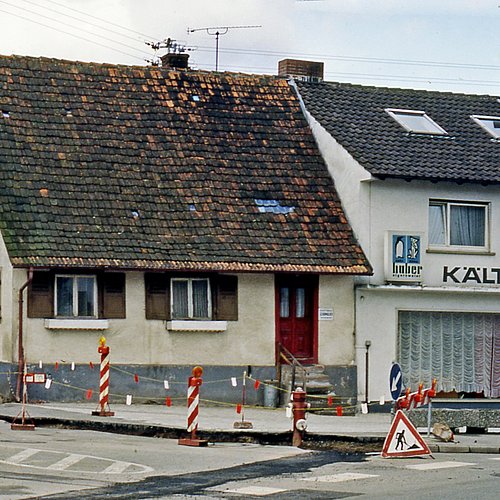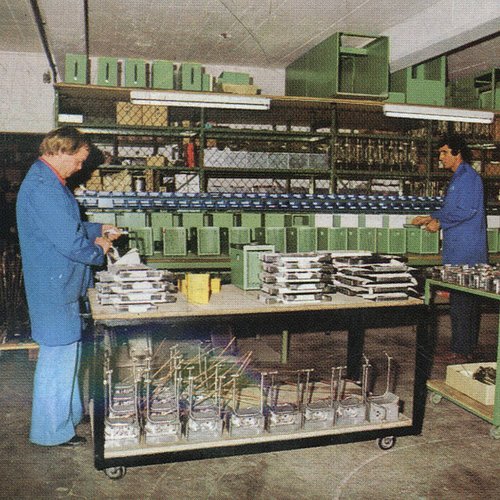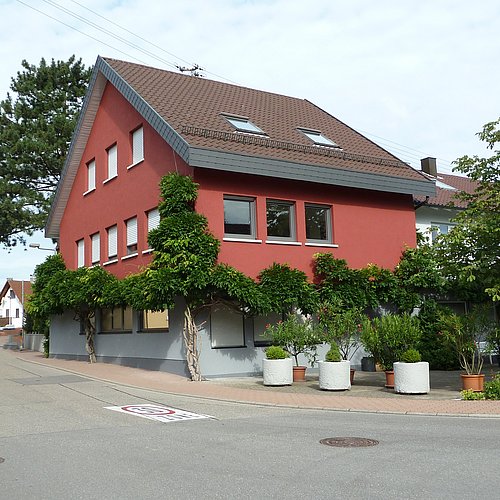The way to technology leader
“Success is an avalanche: It depends on the first snowball,” said Clint Eastwood, who became known less as a corporate consultant and more as a character actor. Peter Huber made his snowball at the end of the 1960s, when the trained machinist got his initial expertise in refrigeration technology and then became a master. His company, founded on April 1, 1968, took over his father’s business premises in the center of Elgersweier. Instead of repairing washing machines, Peter Huber constructed oil cooling machines and chillers for drink dispensers and thermostats in a 2000 square-meter space.
Five employees, including two apprentices, modestly shared the workshop, storage area and office. The start-up initially operated as a subcontractor for companies including such major ones as Linde. It could have gone on like this forever, until a client in the lab sector had the idea to copy Peter Huber’s technology and build their own refrigeration plant.. Peter Huber saw the risk and didn’t want the future of the company to be dependent on these kinds of decisions. This made the decision to launch “Huber” as a brand in its own right into the laboratory market and easy one.
It became revolutionary – this is where the avalanche formed – in 1976 with the development of the world’s smallest refrigerated circulator. At first it was analog and in 1980 it featured an interchangeable digital controller for all lab thermostats. The Ministat had the right format and followed the principle that “our products must sell themselves”. Peter Huber’s refrigeration, bath and circulation thermostats had a particularly small footprint and wide temperature ranges.
But the customers were soon delighted by the short amortization periods. One client after another was captivated by the new principle and stayed with it. “A competitor once said about us that “Huber is like a virus. Once a company has a Huber product, you won’t remove them,” reports Daniel Huber, chairman of the Executive Board.
While the Ministat users could save space, its high demand meant that Huber had to expand its production area. “There was actually always construction,” is how Daniel Huber remembers his childhood, when the apartment was upstairs and the workshop below.
A turning point in those days was the collaboration with the pharmaceutical giants Hoffmann-La Roche and Ciba-Geigy (now Novartis) in Switzerland. To introduce the Tango, Peter Huber and his manager of electronics development, Dieter Pforte, traveled to Basel. Both were committed to the project and it consumed them entirely. Peter Huber worked 16 hours a day while Dieter Pforte was known to sleep at the office sometimes. The magical moment for Baden engineering technology started with a disaster as the Tango® would not function during its first test run at Ciba-Geigy. Was this “Demonstration effect”, a hidden fault?
Soon the slogan “It takes two to tango” was used to promote the Tango and the Tango Factory built in 1998. Just like the new control technology that was also compatible with older devices, this saying fits the past, because success was always a shared achievement – between Huber and Pforte, Huber and its employees and Huber and its customers, which Peter Huber called “the best customers in the world”. Now things started happening fast. The Tango® soon left its competition behind, since it could do much more and do it faster and more accurately than comparable machines.
Peter Huber’s children gradually joined the business, which received a new boost with the move into the new Tango Factory in Werner-von-Siemens-Strasse. The avalanche was far from over. One reason for the worldwide demand was the cooperation with Hoffmann-La Roche AG as of 2006 and the adoption of its greenhouse policy (K6 Directive) which is being applied even where local law does not require it (it is still the same planet regardless of the territory!). When water became scarce in California, the United States started to think differently. With its natural coolants in tempering machines, Huber was in the right place at the right time.
The cooperation with the Offenburg University of Applied Sciences was another stroke of luck. This brought about the Tango Nuevo, which then generated “offspring” – the Grande Fleur and Petite Fleur. The innovations (Pilot ONE, control technology) were complemented by numerous prizes as well as a new strategic orientation.
The company laid the groundwork by transitioning from a GmbH (limited liability company) to an AG (public limited company) and acquiring Van der Heijden Labortechnik GmbH. 2016 became the year of superlatives. Since 2010, Huber has grown rapidly, hired and trained new employees (current status worldwide a total of 490), construction activity is starting and new branches are opening. Every week new applications are being discovered for the automotive, aerospace and other sectors. If not before, it was now finally clear that Peter Huber had formed not just one snowball in 1968 but several. At the Tango Factory, this is certainly considered „very cool“.


